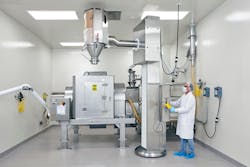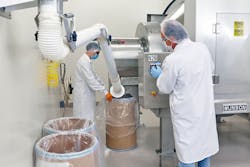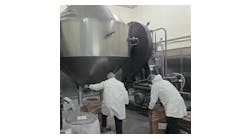Case study: Nutraceutical blending cycles cut 90% with switch to rotary batch mixing
A&Z Pharmaceutical is a developer, manufacturer and marketer of pharmaceutical products and nutritional supplements based in Hauppauge, New York. With increasing demand for its health and wellness nutraceutical supplements, the company built a 26,700-square-foot wing and production line in Hauppauge dedicated to nutraceutical products that were previously produced at another site. By opting for rotary batch mixing over the V-cone blending employed on the previous lines, A&Z was able to cut blending times on the new production line by more than 90%.
Quantifying differences between two tumble-type mixers
“Chiefly, we needed to uniformly blend dry ingredients without compacting them,” said Marian Vija, director of research and development at A&Z. “We make claims of uniformity for all the active ingredients in our formulations and have to meet those claims in the final product — capsule, tablet and powder drink.” The company also desired shorter mixing cycle times with no product damage or segregation of materials.
The V-cone blenders did the job on the existing calcium and vitamin D production lines, but typically took 45 to 60 minutes per batch to achieve the desired uniformity, prompting A&Z to purchase of a 40-cubic-foot capacity stainless steel model 700-TS-40-SS rotary batch mixer from Munson Machinery, a bulk solids handling and processing equipment supplier based in Utica, NY. The unit contains internal mixing flights that tumble, cut, turn and fold the batch, causing particles to recombine 288 times per minute, achieving batch uniformity in four minutes, or 11 to 15 times faster than the A&Z’s V-cone blenders. The company also gained production flexibility, as the mixer is equally efficient from 100% down to 15% of rated capacity.
A&Z establishes rigid blending protocol
On the production line, an operator starts the empty mixer and uses a drum lift to transfer ingredients from fiber drums into the mixer's stationary inlet in a prescribed order, following the steps in the master batch record.
“Half of the time, they are very fluffy materials that would occupy the whole volume of the machine,” said Vija. “So we load them in and add another material to reduce the volume.”
For formulations intended for tablets or capsules, a dry lubricant such as magnesium stearate powder is added to the ingredients. This is a critical parameter in the mixing procedure, because one gram of magnesium stearate can lubricate 247 to 318 cubic feet of material. Excessive lubricant or overmixing will prevent formulation particles from sticking together during tableting. Adding lubricant extends the mixing time in the rotary batch mixer by about half a minute, versus five minutes in the V-blenders.
“The shorter mixing time makes overmixing and/or over-lubricating less likely,” said Vija.
The blended batch is unloaded into the same fiber drums in which the ingredients arrived. Lined with GMP-compliant plastic bags, the drums are staged beneath the mixer’s discharge gate, and filled as one operator at the control panel adjusts the mixer to rotate slowly, while a second operator positions each fiber drum below the gate.
GMP sanitizing procedure prevents cross contamination
A&Z established a protocol that complies with FDA Good Manufacturing Practices for sanitizing and preventing cross-contamination. Once the mixing vessel is emptied, it is put under vacuum to remove residual dust. Large access doors on opposite sides of the mixing vessel are then opened and any remaining product vacuumed, after which the interior is pressure washed with hot water, and the vessel is rotated for several minutes. After the water is drained, a hot-water cleaning solution is added, and the mixer is rotated for several additional minutes. That solution is removed, and the interior is again hosed down and drained and/or softly brushed as necessary. For a final rinse, hot water is added, and the blender is rotated for several minutes and then drained. One liter of 70% isopropyl alcohol is added, then the mixer is rotated 10 times and drained. This step is then repeated, after which the mixer is dried under vacuum for two hours and is ready for another cycle.
The large doors of the vessel allow unobstructed access for cleaning and visual inspection of all product contact surfaces, which Vija says can be accomplished without moving the drum.
Results predetermined through laboratory testing
Actual A&Z nutraceutical ingredients were tested at the supplier’s facility using a laboratory-sized rotary batch mini mixer, with four minutes established as the optimum mixing time. A&Z also performed content uniformity studies on commercial batches made in the rotary batch mixer in production. “We obtained excellent results: uniformity and a good mixing procedure,” said Vija. “The blends are suitably robust for compressing and encapsulation.”
Stephen J. Knauth is the marketing and technical manager for Munson Machinery Co., Inc. Established in 1823, Munson Machinery is a world leader in mixers, blenders and size reduction equipment for bulk solid materials. Munson offers 17 high-performance equipment lines, each with numerous models to meet specialized requirements in the chemical, pharmaceutical, nutritional, food, coffee/tea, refractories, powder metal and other industries.
Munson Machinery



